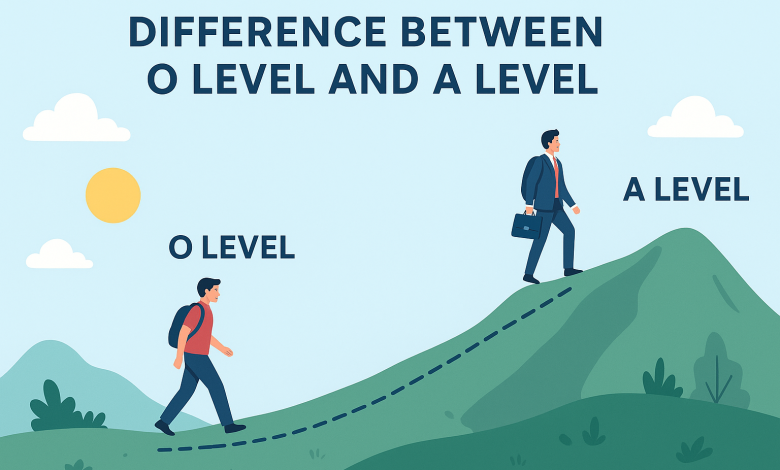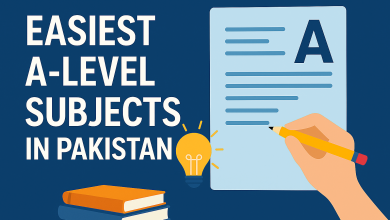Difference between O Level and A level
Unsure whether O Level or A Level is right in Pakistan? This comprehensive guide breaks down subjects, difficulty, costs, recognition, IBCC equivalence, and includes tips for parents to choose the right track for their child.
Finding the right educational direction is a life-shaping decision for students and parents in Pakistan. In the world of British qualifications, O Levels in Pakistan and A Levels in Pakistan are the two names that surface repeatedly as the most recognized and widely chosen academic routes. The key debate remains: what’s the difference between O Levels in Pakistan and A Levels in Pakistan? Which is more challenging, how much do they cost, and which pathway opens doors to better opportunities for admission into top universities in Pakistan and abroad?
In this guide, ForiEDU brings you an in-depth, detailed, and easy-to-understand comparison between O Levels in Pakistan and A Levels in Pakistan, so parents and students can make informed decisions.
What Are O Levels and A Levels?
- O Level (Ordinary Level) in Pakistan acts as the equivalent to Matric/Secondary School Certificate (SSC) for students aged 14–16, where exams are administered by Cambridge (CAIE) and Edexcel.
- Known as Advanced Level, A Levels in Pakistan is equivalent to the Intermediate/Higher Secondary School Certificate (HSSC). Taken after O Levels, typically by students aged 16–19, and serve as a pre-university bridge.

Duration & Structure
| Aspect | O Level | A Level |
| Age Group | 14–16 years | 16–19 years |
| Duration | 3 years | 2 years |
| Equivalent in Pakistan | Matric/SSC | FSc/Intermediate |
| Exam Boards | Cambridge, Edexcel, Oxford AQA | Cambridge, Edexcel, Oxford AQA |
| Focus | Broad subject foundation | Specialised, in-depth subjects |
Subjects & Curriculum
- O – Levels:
- Extensive Subject Choices: English, Math, Sciences, Urdu, Islamiat, Pakistan Studies (compulsory for Pakistan), plus electives like Business, ICT, Art, etc.
- On average, O Level candidates normally sit for 8 to 10 subjects to complete their qualification.
- A Levels:
- The program is narrower in scope, requiring students to select 3–4 subjects that are relevant to their academic and career direction.
- Top subject groups chosen by students in Pakistan (O Levels & A Levels):
- Pre-Medical (Biology, Chemistry, Physics)
- Pre-Engineering (Maths, Physics, Chemistry)
- Business/Commerce (Economics, Business, Accounting)
- Humanities & Arts (Sociology, Law, Psychology, Literature)
Difficulty Level
- O Level: O Levels in Pakistan aims to build a solid base for further studies, while exams test basic to intermediate knowledge, and even though the workload is demanding, it is considered manageable.
- A Level: Compared to O Levels, A Level qualification in Pakistan is recognised for its challenging nature, involving analytical and detailed syllabus. Students are required to hone their critical thinking, essay writing, research, and advanced problem-solving skills.
Student Perspective: Transitioning from O Levels in Pakistan to A Levels in Pakistan feels dramatic. Although the subject numbers drop, the content is deeper, more analytical, and the level of difficulty rises sharply.
Grading System
- O Level: A*–E grading (A* being highest).
- A Level: A*–E grading as well, but academic performance requirements intensify when shifting from O Levels in Pakistan to A Levels in Pakistan.
For university entry in Pakistan, they require minimum grades in A Levels, with medical admission equivalence usually requiring three Bs.

Costs in Pakistan
- O Levels: The expense of O Levels and A Levels in Pakistan usually range between PKR 25,000–35,000 (board and year dependent), whereas tuition in private schools add significantly to total costs.
- A Levels: The financial burden of A Levels in Pakistan is higher, around PKR 30,000–45,000 per subject. With 3–4 subjects, costs can surpass PKR 120,000–150,000.
Despite being costlier than Matric and Intermediate, parents continue to prefer O Levels and A Levels in Pakistan over Matric and Intermediate for their global recognition and academic worth.
Recognition & University Admissions in Pakistan
Equivalence:
- O Level = Matric equivalence via IBCC (Inter Board Committee of Chairmen).
- A Level = Intermediate/FSc equivalence via IBCC.
Admissions:
- Universities in Pakistan (LUMS, NUST, Aga Khan, IBA, etc.) accept A Levels but require equivalence certificates.
- Crucial for students: To qualify for medical and engineering admissions in Pakistan, candidates are required to subject prerequisites and minimum grade criteria, most critical at the A Level stage in Pakistan.
Abroad: Globally respected, O Levels in Pakistan and A Levels in Pakistan open up doors to leading universities across the UK, United States, Canada, and Australia.
Pros & Cons
To put things into perspective, here’s a quick breakdown of O Levels and A Levels in Pakistan:
| Qualification | Advantages | Disadvantages |
| O Levels in Pakistan | ✅ Globally recognized ✅ Builds a strong subject foundation | ❌ More expensive compared to Matric in Pakistan ❌ Workload of 8–10 subjects |
| A Levels in Pakistan | ✅ Internationally respected pre-university qualification ✅ Focused subject choices align better with future careers | ❌ Academically more demanding ❌ Higher costs than O Levels |
How to Choose Between O Level & A Level?
- Long-Term Career Goals:
- If international study is your dream, then A Levels in Pakistan make admission easier.
- When pursuing MBBS or Engineering in Pakistan, Ensure your A Level and O Level subject combinations align with IBCC equivalence requirements.
- Cost Factor: O Levels in Pakistan and A Levels in Pakistan are pricier compared to the local Matric and Intermediate system.
- Preferred Approach: A Levels in Pakistan are a strong match for students who thrive on analytical thinking and conceptual study.
ForiEDU Suggestion: Before enrolling in O Levels or A Levels in Pakistan, get expert input from a tutor or educational consultant to to understand your child’s academic strengths.
Conclusion
The road to O Levels or A Levels in Pakistan is shaped by three signposts: cost, career goals, and learning style. O Levels in Pakistan build knowledge brick by brick, while A Levels in Pakistan act as the bridge to global higher education. The journey is challenging, but the achievements are remarkable.
At foriEDU.com, we connect students from every corner of Pakistan with professional online tutors for O Levels and A Levels, guiding them toward success. We support students with subject choice, exam preparation and IBCC equivalence guidance, ensuring personalized learning for O Levels and A Levels in Pakistan is a nationwide reality.
Your Next Step:
Find Qualified O & A Level Tutors in Pakistan at ForiEDU.
FAQs: O Level vs A Level in Pakistan
Q1: Can I skip O Levels and go straight to A Levels?
While technically possible, it’s highly discouraged as O Level create the academic base necessary to succeed in A Levels.
Q2: Is A Level harder than O Level?
Correct. A Levels in Pakistan reduce the number of subjects,A Levels in Pakistan reduce the number of subjects, but the study is far deeper and highly analytical.
Q3: Which is better in Pakistan, A Level or Intermediate (FSc)?
Both qualifications are valid. A Levels in Pakistan come with higher costs but carry international recognition, while Intermediate is more economical and locally aligned.
Q4: How much do A Levels cost in Pakistan?
In Pakistan, the total expense of O Levels and A Levels exam and tuition fees together often goes beyond PKR 200,000+, varying by school and subjects.
Q5: Which universities in Pakistan accept A Levels?
With IBCC equivalence, students with A Levels in Pakistan are accepted into nearly every top-tier university including LUMS, IBA, NUST, Aga Khan, FAST, and UMT.




Excellent way of explaining, and pleasant post
to obtain facts concerning my presentation focus, which i am
going to present in university.
I have read this post and if I could I want to suggest you some fascinating
things or tips. Perhaps you can write next articles referring to
this article. I wish to learn more things!
The point of view of your article has taught me a lot, and I already know how to improve the paper, thank you.